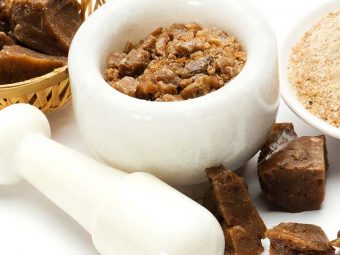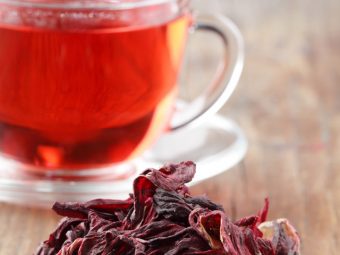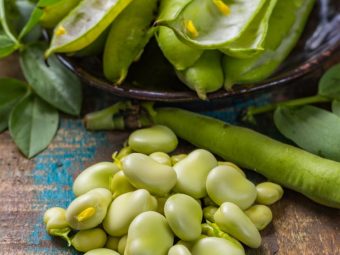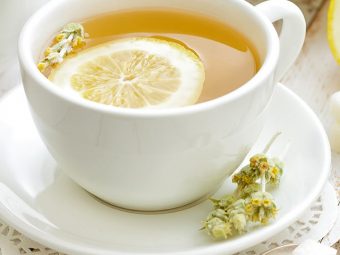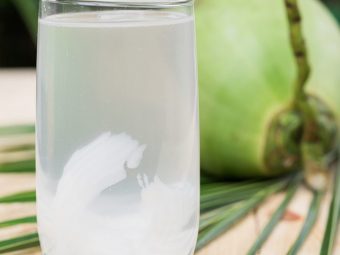[ad_1]
Chervil’s benefits extend beyond its subtle aroma, which can transform a bland dish into a delicacy. It is an integral part of the fines herbes seasonings used in French cuisine. Chervil is believed to make people merry, sharpen their wits, rejuvenate the body, and symbolize sincerity. Its delicate flavor brings out the best in mild sauces and dishes. This herb is packed with antioxidants, minerals, and vitamins that can help boost digestion and circulation. It can also reduce inflammation and bloating. Discover more about chervil’s benefits and how to make the most of it in this article. Keep reading.
What Is Chervil?
Chervil or garden chervil (Anthriscus cerefolium L. Hosffm.) is a popular herb in France. Europeans and Asians usually use this herb for cooking.
Its subtle anise and licorice-like flavor make it a great option for garnishing many dishes (1).
Chervil has dainty white flowers and green, almost flower-like leaves. Several parts of this plant are edible, including leaves, roots, and seeds. Its fresh, preserved, and dried leaves are often used in pesto-like preparations. Chervil is part of the fines herbes of French haute cuisine along with parsley, chives, and tarragon (1), (2).
You may also know it as French parsley due to its close resemblance to parsley. They look alike and belong to the same scientific family (Apiaceae or Umbelliferae). However, chervil has a more delicate flavor and potency than parsley, and it is not commonly used in cooking. Therefore, the cooking preferences of parsley and chervil differ (1).
Chervil is available in four varieties (2) :
- Garden chervil
- Root chervil (Turnip root chervil)
- Wild chervil (Anthriscus sylvestris)
- Bur chervil (Anthriscus caucalis)
Garden chervil is the commonly used variety of the herb. Chervil has been revered since ancient times. Its leaves were traditionally called ‘Myrrhis’ as the aroma of the oil extracted from the leaves resembles the biblical resin ‘myrrh.’ Many herbalists believed this herb had medicinal properties (2).
Dr. Linda Khoshaba, NMD, FABNE, says, “Chervil has been used as a diuretic, expectorant, digestive aid, skin freshener, and breath freshener. It was also thought to help with eczema, gout, kidney stones, and pleurisy.”
Chervil is rich in minerals, vitamins, and bioactive compounds, which may help relieve many disorders. Learn more about chervil’s nutrient profile in the next section.
Nutritional Information Of Chervil
A 100 gram of dried chervil contains (3):
| Calories | 237 kcal |
| Protein | 23.2 g |
| Carbohydrate | 49.1 g |
| Total lipids (Fat) | 3.9 g |
| Sodium | 83 mg |
| Potassium | 4740 mg |
| Calcium | 1350 mg |
| Iron | 32 mg |
| Magnesium | 130 mg |
| Phosphorus | 450 mg |
| Zinc | 8.8 mg |
| Manganese | 2.1 mg |
| Selenium | 29.3 µg |
| Dietary fiber | 11.3 g |
| Vitamin C | 50 mg |
Flavonoids are the major compounds present in chervil. It is also a good source of essential oil (0.3% in the fresh herb, 0.9% in the seeds). The oil contains compounds such as methyl chavicol (estragole) and hendecane (undecane) (2).
Chervil’s diverse and rich nutrient profile makes it beneficial for our health.
Potential Health Benefits Of Chervil
1. Good Source Of Antioxidants
Chervil contains powerful antioxidants like phenolic compounds, flavonoids, and vitamin C. These antioxidants are necessary for reducing early signs of aging, such as fine lines and wrinkles. Additionally, they reduce oxidative stress and free radical levels. The antioxidants also promote healthy skin and organ function (2), (4), (5), (6).
2. May Fight Against Infection
Chervil contains bioactive compounds that can inhibit pathogenic bacteria such as Staphylococcus aureus and fungi such as Candida albicans. Pneumonia is associated with these pathogens. Chervil’s antimicrobial activity explains why it is used in traditional medicine to treat pneumonia (7).
3. May Reduce Inflammation
Chervil has anti-inflammatory properties and can effectively treat inflammation related to colds and flu. Chervil leaves may also help manage eczema symptoms like redness, itching, and swelling (2).
4. May Promote Digestion
Chervil is rich in dietary fibers. Dietary fiber helps maintain digestive health, improves fecal frequency and weight, and reduces transit time for digesting and excreting food (8).
5. May Act As Stimulant
Chervil is thought to be a mild stimulant. It may lift your mood and temporarily stimulate physiological activity (2).
6. May Relieve Congestion
Chervil is considered a good expectorant as it promotes mucus secretion from the respiratory system. This makes it easier to clear airway obstruction and reduce congestion by eliminating the secretion through coughing (2), (9), (10).
7. May Reduce Premenstrual Bloating
Chervil works well as a diuretic (it helps the body eliminate excess fluid and salt). The herb increases urine output and may help reduce fluid retention and bloating during menstruation or pre-menstruation (2), (11).
8. May Boost Skin Health
Chervil leaves are useful for inflammatory skin conditions such as eczema, psoriasis, Systemic Lupus Erythematosus (SLE), and acne. Consuming chervil juice can improve and heal the skin from wounds and scars. Fresh chervil leaf infusions are used as skin cleansers and lotions. Applying its juice may also reduce blemishes (2).
9. May Promote Circulation
Taking chervil with herbal teas may improve blood circulation. It is a rich source of iron and zinc and helps prevent anemia. Chervil has anti-hypertensive properties and can ease the symptoms of high blood pressure. The herb is also used as a blood purifier (2).
Chervil’s health benefits are still being studied. Nonetheless, such an exquisite, subtle spice cannot be overlooked. Find out how you can incorporate it in your diet below.
How To Add Chervil To Your Diet
- Infused Vinegar: Khoshaba says, “To keep chervil’s taste, you can put it in white wine vinegar and keep it for a long time. To add flavor to food, it doesn’t need a lot of other things. This makes it a low-calorie way to spice up your food.”
- Garnish: Chervil leaves or whole sprigs are delicate and can be used to garnish your creamy soups, butter sauces, scrambled eggs, and omelets.
- Seasoning: Chervil is most commonly used in classical French herb seasoning fines herbes. You can also use it on its own to flavor mild dishes.
- Sauces: Chervil is also an excellent addition to light sauces, mild cheeses, and herb butter.
Keep the following tips in mind when cooking with chervil:
- Chervil has a mild flavor that is easily lost when dried or heated.
- Add chervil at the end of the cooking process to retain its flavor.
- It is better to use fresh leaves for cooking and garnishing.
Therefore, you need to be careful when using chervil. When overcooked, chervil loses its subtle, delicious flavor. However, watch out for possible risk factors. Not everyone will benefit from chervil. Read on for the reasons.
Possible Side Effects And Allergies
Chervil has been designated as GRAS (Generally Recognized As Safe), and the FDA considers it safe for culinary use. However, since studies evaluating the effects of excess consumption of chervil have not been conducted, it is advised to avoid eating too much of it (8).
Chervil allergies are extremely rare. However, a 43-year-old patient reported chervil allergy symptoms such as throat itching, uvula swelling, voice change, and diarrhea. Researchers identified a unique 14 kDa thermostable allergen in chervil, which may cause allergic reactions(12). Therefore, if you notice any adverse reactions after consuming chervil, contact your healthcare provider.
The Final Word
Chervil is a widely used French herb with a mild flavor. It is a popular garnish that can elevate the taste of mild dishes and is a great addition to herb blends, seasonings, and infused vinegar. It is loaded with antioxidants, minerals, vitamins, and many bioactive compounds. The benefits of chervil include reducing inflammation and bloating, fighting infection, and improving digestion. Since it easily loses flavor to overheating, be careful when using it in the dishes. There is a rare chance you might be allergic to chervil. However, consult your doctor if you notice any symptoms.
Key Takeaways
- Chervil is a popular garnishing herb known for its subtle licorice-like flavor.
- It is frequently used in French cuisine and is packed with beneficial bioactive compounds, antioxidants, vitamins, and minerals.
- It may help promote digestion, reduce inflammation, relieve congestion, and even rejuvenate your skin.
Frequently Asked Questions
Is chervil the same as cilantro?
No. Although both look the same, chervil and cilantro have different taste profiles and culinary uses.
What herb is similar to chervil?
Chervil resembles and can be substituted with tarragon, parsley, dill, and savory.
Is chervil the same as parsley?
No. They are closely related and are often used interchangeably, chervil has a mild flavor compared to parsley.
Can you eat chervil seeds?
Yes. Chervil seeds are edible and have a mild anise-like taste.
What kind of spice is chervil?
Chervil is a popular culinary herb, a condiment, and not a spice.
Sources
Articles on StyleCraze are backed by verified information from peer-reviewed and academic research papers, reputed organizations, research institutions, and medical associations to ensure accuracy and relevance. Read our editorial policy to learn more.
- Chervil
https://www.sciencedirect.com/science/article/pii/B9781855737211500122 - Chervil: A Multifunctional Miraculous Nutritional Herb
https://scialert.net/fulltext/?doi=ajps.2012.163.171 - Food Data Central
https://fdc.nal.usda.gov/fdc-app.html#/food-details/171318/nutrients - In vitro antioxidant activity of Anthriscus cerefolium L. (Hoffm.) extracts
https://www.sciencedirect.com/science/article/abs/pii/S0378874199001713 - ANTIOXIDANT ACTIVITY OF DIFFERENT COMPOUNDS FROM ANTHRISCUS CEREFOLIUM L. (HOFFM.)
https://www.actahort.org/books/597/597_26.htm - The Role of Antioxidants in Human Health
https://pubs.acs.org/doi/full/10.1021/bk-2011-1083.ch001 - Extract of Herba Anthrisci cerefolii: Chemical Profiling and Insights into Its Anti-Glioblastoma and Antimicrobial Mechanism of Actions
https://www.mdpi.com/1424-8247/14/1/55/htm - Dietary fiber and digestive health in children
https://academic.oup.com/nutritionreviews/article/75/4/241/3747768?login=true - Mucolytics, expectorants, and mucokinetic medications
https://pubmed.ncbi.nlm.nih.gov/17594730/ - Systematic review of randomised controlled trials of over the counter cough medicines for acute cough in adults
https://www.ncbi.nlm.nih.gov/labs/pmc/articles/PMC65295/ - Fluid Retention over the Menstrual Cycle: 1-Year Data from the Prospective Ovulation Cohort
https://www.ncbi.nlm.nih.gov/labs/pmc/articles/PMC3154522/ - Garden Chervil ( Anthriscus cerefolium), a novel food allergen
https://www.worldallergyorganizationjournal.org/article/S1939-4551(20)30215-5/fulltext#relatedArticles
Related
LATEST ARTICLES
[ad_2]








